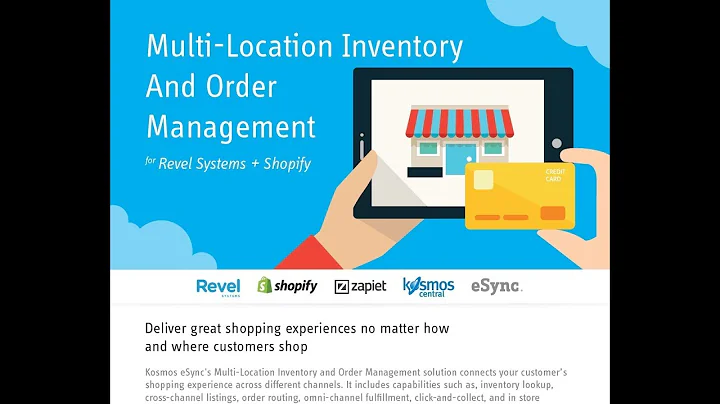Streamline Your Operations: Integrating Microsoft Dynamics and Shopify
Table of Contents:
- Introduction
- What is Microsoft Dynamics?
- What is Shopify?
- Need for Integration
- Integrating Microsoft Dynamics and Shopify
- Overview of DBSync's Cloud Workflow iPaaS Solution
- Logging into DBSync
- Connecting Microsoft Dynamics
- Entering User Credentials
- Validating Connection
- Connecting Shopify
- Connecting to the Store
- Syncing Orders between Shopify and Dynamics
- Setting Up the Test Store in Shopify
- Adding Products to the Cart and Checking Out
- Additional Features of DBSync
- Accounting Integration
- Database Integration
- Integration with Third-Party Applications and Open APIs
- Scheduling and Automation
- Using the Scheduler to Set Sync Time and Frequency
- Running the Sync Process
- Monitoring and Troubleshooting with Logs
- Viewing Synced Orders in Microsoft Dynamics
- Conclusion
- Benefits of Using DBSync for Integration
- Contact Information
Article:
Integrating Microsoft Dynamics and Shopify using DBSync's Cloud Workflow iPaaS Solution
Introduction
In today's digital era, businesses often rely on multiple software systems to manage various aspects of their operations. Integrating these systems can streamline processes, improve efficiency, and provide a unified view of data. This article will guide you through the integration of Microsoft Dynamics and Shopify using DBSync's Cloud Workflow iPaaS Solution.
-
What is Microsoft Dynamics?
Microsoft Dynamics is a suite of business applications that help organizations manage their customer relationships, finance, supply chain, and more. It offers a wide range of functionalities for various industries and is known for its flexibility and scalability.
-
What is Shopify?
Shopify is a popular e-commerce platform that allows businesses to create online stores and sell products or services. It offers a user-friendly interface, customizable themes, and a range of features for managing inventory, processing payments, and marketing.
-
Need for Integration
Many businesses choose to use Shopify as their customer-facing e-commerce platform, while relying on Microsoft Dynamics for marketing automation, warehouse management, or fulfillment. Integrating these systems ensures seamless data flow between them, eliminates manual data entry, and enables better decision-making.
Integrating Microsoft Dynamics and Shopify
Overview of DBSync's Cloud Workflow iPaaS Solution
DBSync's Cloud Workflow iPaaS Solution is an integration platform as a service that enables businesses to connect and synchronize data between various endpoints, including Microsoft Dynamics and Shopify. It offers a range of connectors and features to simplify the integration process.
Logging into DBSync
To begin the integration process, log into DBSync and access the Development Studio tab. Here, you will find different projects corresponding to various integrations.
Connecting Microsoft Dynamics
-
Entering User Credentials
In the Microsoft Dynamics project, enter your username, credentials, password, and CRM login URL. Once entered, click "Validate Connection" to ensure a successful connection.
-
Validating Connection
If the connection validation is successful, you are ready to proceed with the integration on the Dynamics side.
Connecting Shopify
To connect Shopify to DBSync, select the Shopify project. Here, you can connect to the Shopify store you are logged into. Follow the prompts to establish the connection.
Syncing Orders between Shopify and Dynamics
The most common use case for integration is syncing orders from Shopify to Microsoft Dynamics, including customer information, order details, and product information.
-
Setting Up the Test Store in Shopify
Open your test Shopify store, add products to the cart, and proceed to checkout. This will generate an order for testing purposes.
-
Adding Products to the Cart and Checking Out
Use the provided Shopify payment gateway and proceed with the payment process. Once the order is processed, you will receive a thank you message from Shopify.
Additional Features of DBSync
Apart from the Microsoft Dynamics and Shopify integration, DBSync offers several other integration capabilities.
-
Accounting Integration
DBSync provides integration with accounting systems, allowing for the seamless synchronization of financial data. This integration can eliminate manual data entry and ensure accurate financial reporting.
-
Database Integration
DBSync can connect with major databases, facilitating the transfer of data between different systems. This enables businesses to have a centralized and up-to-date database.
-
Integration with Third-Party Applications and Open APIs
DBSync's versatility extends to integrating with third-party applications and systems. Using open APIs, businesses can connect DBSync to various software solutions, expanding the scope of integration possibilities.
Scheduling and Automation
DBSync offers scheduling and automation features to ensure timely and accurate data synchronization.
-
Using the Scheduler to Set Sync Time and Frequency
With DBSync's scheduler, you can set the frequency of data sync between Microsoft Dynamics and Shopify. Choose the desired time interval, such as every 5 or 10 minutes, or opt for a batch sync at the end of the day.
-
Running the Sync Process
In the Processes section, initiate the sync process manually or automate it based on the scheduler settings. This will push all pending orders from Shopify to Microsoft Dynamics.
-
Monitoring and Troubleshooting with Logs
DBSync provides a comprehensive log function that records the number of records read, received, and written during each sync process. This information enables quick troubleshooting in case of any issues.
Viewing Synced Orders in Microsoft Dynamics






















